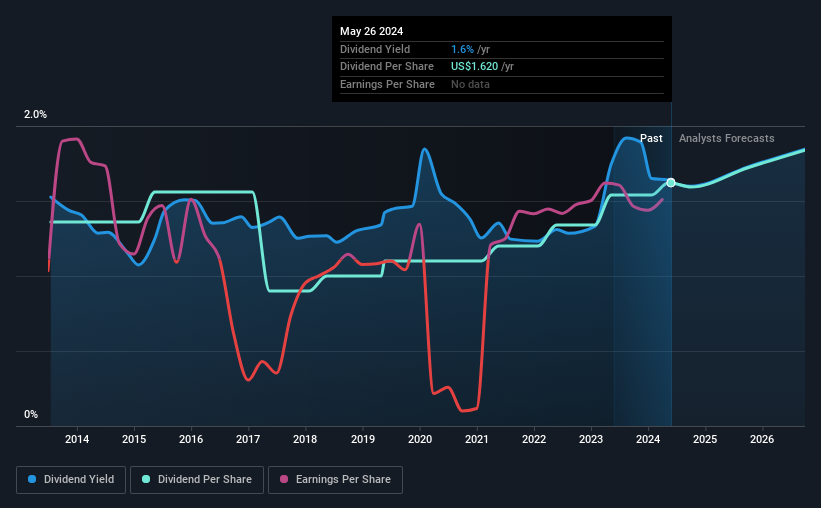Ashland Inc. (NYSE:ASH) Looks Interesting, And It's About To Pay A Dividend
Readers hoping to buy Ashland Inc. (NYSE:ASH) for its dividend will need to make their move shortly, as the stock is about to trade ex-dividend. The ex-dividend date is one business day before a company's record date, which is the date on which the company determines which shareholders are entitled to receive a dividend. The ex-dividend date is important because any transaction on a stock needs to have been settled before the record date in order to be eligible for a dividend. This means that investors who purchase Ashland's shares on or after the 31st of May will not receive the dividend, which will be paid on the 15th of June.
The company's next dividend payment will be US$0.405 per share, and in the last 12 months, the company paid a total of US$1.62 per share. Calculating the last year's worth of payments shows that Ashland has a trailing yield of 1.6% on the current share price of US$99.65. If you buy this business for its dividend, you should have an idea of whether Ashland's dividend is reliable and sustainable. As a result, readers should always check whether Ashland has been able to grow its dividends, or if the dividend might be cut.
View our latest analysis for Ashland
Dividends are typically paid from company earnings. If a company pays more in dividends than it earned in profit, then the dividend could be unsustainable. Ashland paid out a comfortable 43% of its profit last year. A useful secondary check can be to evaluate whether Ashland generated enough free cash flow to afford its dividend. Fortunately, it paid out only 26% of its free cash flow in the past year.
It's encouraging to see that the dividend is covered by both profit and cash flow. This generally suggests the dividend is sustainable, as long as earnings don't drop precipitously.
Click here to see the company's payout ratio, plus analyst estimates of its future dividends.
Have Earnings And Dividends Been Growing?
Companies with consistently growing earnings per share generally make the best dividend stocks, as they usually find it easier to grow dividends per share. If business enters a downturn and the dividend is cut, the company could see its value fall precipitously. It's encouraging to see Ashland has grown its earnings rapidly, up 65% a year for the past five years. Ashland is paying out less than half its earnings and cash flow, while simultaneously growing earnings per share at a rapid clip. Companies with growing earnings and low payout ratios are often the best long-term dividend stocks, as the company can both grow its earnings and increase the percentage of earnings that it pays out, essentially multiplying the dividend.
Another key way to measure a company's dividend prospects is by measuring its historical rate of dividend growth. In the last 10 years, Ashland has lifted its dividend by approximately 1.8% a year on average. Earnings per share have been growing much quicker than dividends, potentially because Ashland is keeping back more of its profits to grow the business.
Final Takeaway
Is Ashland an attractive dividend stock, or better left on the shelf? It's great that Ashland is growing earnings per share while simultaneously paying out a low percentage of both its earnings and cash flow. It's disappointing to see the dividend has been cut at least once in the past, but as things stand now, the low payout ratio suggests a conservative approach to dividends, which we like. There's a lot to like about Ashland, and we would prioritise taking a closer look at it.
With that in mind, a critical part of thorough stock research is being aware of any risks that stock currently faces. Our analysis shows 2 warning signs for Ashland and you should be aware of these before buying any shares.
A common investing mistake is buying the first interesting stock you see. Here you can find a full list of high-yield dividend stocks.
Have feedback on this article? Concerned about the content? Get in touch with us directly. Alternatively, email editorial-team (at) simplywallst.com.
This article by Simply Wall St is general in nature. We provide commentary based on historical data and analyst forecasts only using an unbiased methodology and our articles are not intended to be financial advice. It does not constitute a recommendation to buy or sell any stock, and does not take account of your objectives, or your financial situation. We aim to bring you long-term focused analysis driven by fundamental data. Note that our analysis may not factor in the latest price-sensitive company announcements or qualitative material. Simply Wall St has no position in any stocks mentioned.

 Yahoo Finance
Yahoo Finance 
